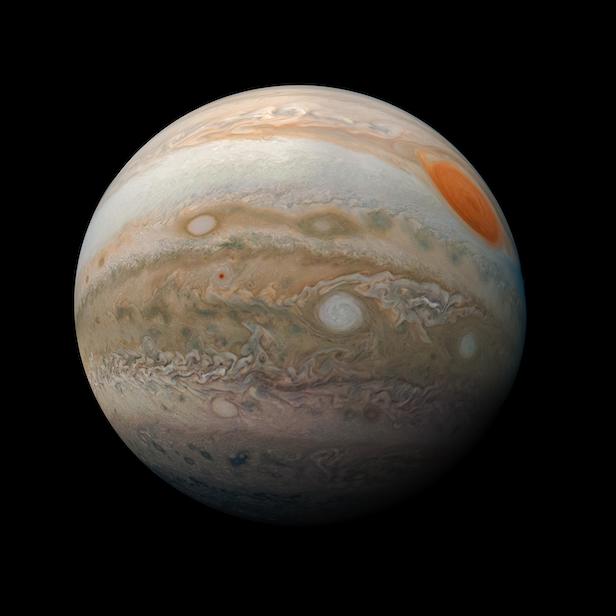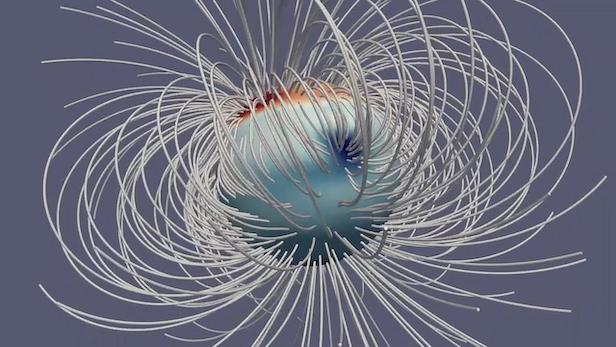Juno Update: Jupiter’s constantly-changing magnetic field is driven by deep winds
This discovery is another important step in understanding the mysterious interior structure of the Solar System’s largest planet

The striking view of Jupiter’s Great Red Spot and turbulent southern hemisphere was captured by NASA’s Juno spacecraft as it performed a close pass of the gas giant planet. Image credit: NASA/JPL-Caltech/SwRI/MSSS/Kevin M. Gill
NASA’s Juno mission to Jupiter made the first definitive detection beyond our world of an internal magnetic field that changes over time, a phenomenon called secular variation. Juno determined the gas giant’s secular variation is most likely driven by the planet’s deep atmospheric winds.
The discovery will help scientists further understand Jupiter’s interior structure – including atmospheric dynamics – as well as changes in Earth’s magnetic field. A paper on the discovery was published recently in the journal Nature Astronomy.
“Secular variation has been on the wish list of planetary scientists for decades,” says Scott Bolton, Juno principal investigator from the Southwest Research Institute in San Antonio, Texas, United States. “This discovery could only take place due to Juno’s extremely accurate science instruments and the unique nature of Juno’s orbit, which carries it low over the planet as it travels from pole to pole.”
Characterising the magnetic field of a planet requires close-up measurements. Juno scientists compared data from NASA’s past missions to Jupiter (Pioneer 10 and 11, Voyager 1 and Ulysses) to a new model of Jupiter’s magnetic field (called JRM09). The new model was based on data collected during Juno’s first eight science passes of Jupiter using its magnetometer, an instrument capable of generating a detailed three-dimensional map of the magnetic field.
What scientists found is that from the first Jupiter magnetic field data provided by the Pioneer spacecraft through to the latest data provided by Juno, there were small but distinct changes to the field.

The image illustrates Jupiter’s magnetic field at a single moment in time. The Great Blue Spot, an-invisible-to-the-eye concentration of magnetic field near the equator, stands out as a particularly strong feature. Image credit: NASA/JPL-Caltech/Harvard/Moore et al.
“Finding something as minute as these changes in something so immense as Jupiter’s magnetic field was a challenge,” says Kimee Moore, a Juno scientist from Harvard University in Cambridge, Massachusetts, United States. “Having a baseline of close-up observations over four decades long provided us with just enough data to confirm that Jupiter’s magnetic field does indeed change over time.”
Once the Juno team proved secular variation did occur, they sought to explain how such a change might come about. The operation of Jupiter’s atmospheric (or zonal) winds best explained the changes in its magnetic field. These winds extend from the planet’s surface to over 3,000 kilometres (1,860 miles) deep, where the planet’s interior begins changing from gas to highly conductive liquid metal. They are believed to shear the magnetic fields, stretching them and carrying them around the planet.
Nowhere was Jupiter’s secular variation as large as at the planet’s Great Blue Spot, an intense patch of magnetic field near Jupiter’s equator. The combination of the Great Blue Spot, with its strong localised magnetic fields, and strong zonal winds at this latitude result in the largest secular variations in the field on the Jovian world.
“It is incredible that one narrow magnetic hot spot, the Great Blue Spot, could be responsible for almost all of Jupiter’s secular variation, but the numbers bear it out,” says Moore. “With this new understanding of magnetic fields, during future science passes we will begin to create a planet-wide map of Jupiter’s secular variation. It may also have applications for scientists studying Earth’s magnetic field, which still contains many mysteries to be solved.”
Try 5 issues of All About Space for just £5! Hurry though, offer ends soon.

Keep up to date with the latest news in All About Space – available every month for just £4.99. Alternatively you can subscribe here for a fraction of the price!




